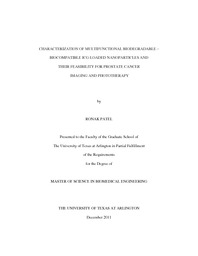
ATTENTION: The works hosted here are being migrated to a new repository that will consolidate resources, improve discoverability, and better show UTA's research impact on the global community. We will update authors as the migration progresses. Please see MavMatrix for more information.
Show simple item record
| dc.contributor.author | Patel, Ronak | en_US |
| dc.date.accessioned | 2012-04-11T20:55:20Z | |
| dc.date.available | 2012-04-11T20:55:20Z | |
| dc.date.issued | 2012-04-11 | |
| dc.date.submitted | January 2011 | en_US |
| dc.identifier.other | DISS-11415 | en_US |
| dc.identifier.uri | http://hdl.handle.net/10106/9547 | |
| dc.description.abstract | Prostate cancer is the most common male cancer in the United States, and the second leading cause of cancer death in men. The conventional diagnostic procedures use an invasive approach to collect the biopsy tissue samples. Also, treatments currently used include radiotherapy, chemotherapy and surgical removal of the prostate associated with high risks of surgical complications. Among all the imaging modalities, Near Infrared (NIR) optical imaging could be a possible candidate for minimally invasive diagnosis of prostate cancer with avoidance of harmful radiation and relatively low cost. This motivation brings the development of multifunctional polymeric (di- lactide-co-glycolic acid) (PLGA) Nanoparticles encapsulating indocyanine green (ICG) which acts as exogenous NIR contrast and thermal agent specific to prostate cancer. The objective of this study was to evaluate and characterize multi-functionality of biodegradable - biocompatible ICG loaded PLGA nanoparticles as thermal ablation agent for cancer therapy and as an optical contrast agent for prostate cancer imaging. The important parameters for particle characterization such as particle size, polydispersity index and ICG loading efficiency were investigated. For optical characterization of nanoparticles, the excitation - emission matrix, absorption spectra and fluorescence lifetime were determined. The photostability study on the optical parameters reveals the stability of PLGA - ICG Nanoparticles (PIN) in aqueous medium. The human dermal fibroblast (HDF) cell viability study demonstrated the cytocompatibility of PIN. Successful cellular uptake of R11 peptide conjugated PIN with prostate cancer (PC3) cells was obtained. Absorption capability of PIN was also explored as a thermal ablation agent through a phantom study and ex vivo tissue phantom studies. Moreover, results of thermal ablation through the phantom study showed an increase of ~ 10 - 12 ˚C in temperature, which is sufficient to create local hyperthermia to treat cancer. The application of PIN as an exogenous contrast was investigated through an ex vivo tissue and in-vivo animal model to examine PIN's ability for enhancing imaging contrast for prostate tumor detection by multi spectral imaging. The results showed great promises, suggesting possible application of PIN towards diagnostic imaging and therapy. | en_US |
| dc.description.sponsorship | Liu, Hanli | en_US |
| dc.language.iso | en | en_US |
| dc.publisher | Biomedical Engineering | en_US |
| dc.title | Characterization Of Multifunctional Biodegradable - Biocompatible ICG-loaded Nanoparticles And Their Feasibility For Prostate Cancer Imaging And Phototherapy | en_US |
| dc.type | M.Engr. | en_US |
| dc.contributor.committeeChair | Liu, Hanli | en_US |
| dc.degree.department | Biomedical Engineering | en_US |
| dc.degree.discipline | Biomedical Engineering | en_US |
| dc.degree.grantor | University of Texas at Arlington | en_US |
| dc.degree.level | masters | en_US |
| dc.degree.name | M.Engr. | en_US |
Files in this item
- Name:
- Patel_uta_2502M_11415.pdf
- Size:
- 1.878Mb
- Format:
- PDF
This item appears in the following Collection(s)
Show simple item record


